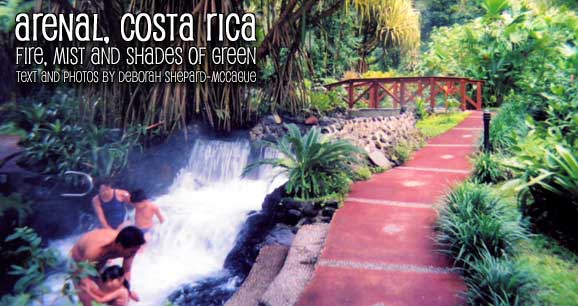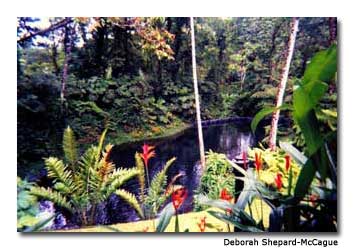
 Plastic hospital-type bracelets are strapped on our wrists as my husband, Thom, and I check into the Tabacón Grand Spa & Thermal Resort. “Makes it easier to identify the bodies,” the front-desk clerk says with a wink. “Be sure to notice the signs showing the evacuation route, and if you’re driving, back your car into the parking space so that you can get out quickly. Answer your phone immediately,” he tells us, “even in the middle of the night, because we will call you in the event of an eruption.”
Plastic hospital-type bracelets are strapped on our wrists as my husband, Thom, and I check into the Tabacón Grand Spa & Thermal Resort. “Makes it easier to identify the bodies,” the front-desk clerk says with a wink. “Be sure to notice the signs showing the evacuation route, and if you’re driving, back your car into the parking space so that you can get out quickly. Answer your phone immediately,” he tells us, “even in the middle of the night, because we will call you in the event of an eruption.”
Although the bracelets are really to allow hotel guests free access to the hot springs, the warnings are part of the procedure for checking into a hotel located at the foot of one of the world’s most active volcanoes, Arenal, of Costa Rica.
After being dormant for 400 years, Arenal erupted with fury in 1968, burying 5.8 square miles (15 km²) in hot lava, rock and ash. Three small towns were destroyed. The roads in the area are still pocked with Volkswagen-size craters and huge, black boulders dot the green pastures where cows now graze peacefully.
The volcano has been active every day since 1968, with two or more eruptions nearly every hour. Hot rocks and lava tumble down the southwest face during eruptions.
A potentially deadly avalanche occurs without warning every two to three years. The guest rooms at Tabacón are located on a small rise, but the Tabacón hot springs lie downhill, directly in the volcano’s path.
Dangerous? Yes, but what an unbelievably beautiful setting for a rain-forest resort and spa with lush tropical gardens, cascades and waterfalls, and steamy hot pools of geothermal mineral water bubbling up directly from the heart of the volcano. There is no place like it on earth.
The Tabacón resort is located between the town of La Fortuna and Lake Arenal, halfway between Costa Rica’s two international airports, San José’s Juan Santamaría and Daniel Oduber Quirós. From San José it takes about three hours to get to the resort on a very crooked, but newly paved, road.
Although closer to Liberia, it takes about the same time, on an equally crooked road that is so full of pot holes it required our driver to spend as much time on the left side as the right. This was nerve wracking on the many blind, hairpin curves with sheer drop-offs and no guard rails.
From either direction, the drive is picturesque. Imagine a tropical Bavaria, complete with chalet-like houses and cows grazing on steep green mountainsides. A stop for a coatimundi to cross the road, and another stop to see a troop of sleeping howler monkeys draped over the branches of a huge tree reminds us of where we are.
Even when shrouded in clouds, the volcano makes its presence known with deep, thunder-like rumbling as we grab our umbrellas, provided by the hotel, and walk to dinner at the restaurant by the hot springs. An open-air, multi-terraced dining area overlooks a big, steamy pool fed by the Tabacón River flowing down the slope.
The nights are cool because of the altitude, which makes the hot springs a favorite evening place. After dinner, we change into bathing suits and test the waters of the various pools and waterfalls, which get progressively hotter as we climb the hillside. We find a quiet and secluded little pool that is just right, and luxuriate under the starry sky. This experience alone is worth our trip to Costa Rica.

If you can drag yourself away from the hot springs, there is plenty to do in this area. Twenty-four-mile-long (39 km) Lake Arenal, a manmade lake, is the largest lake in Costa Rica. Lake Arenal is popular for windsurfing and kite boarding, with strong, steady winds year-round, sometimes blasting at 30 to 40 miles per hour (48 to 64 kph) May through November, and even higher December through April.
There is also excellent fishing for a hard-fighting species of rainbow bass that the locals call guapote,and the flashy, acrobatic fish called machaca. Lodges on the west side of the lake specialize in windsurfing and kite boarding, and lodges on the east side offer fishing and boating.
The Arenal Hanging Bridges are just a five-minute drive from the resort. This is an almost primal experience as you quietly walk along a series of paths and suspension bridges up through a beautiful tract of primary forest into the cloud-forest canopy. When the paths and bridges were being built, jaguars were frequently spotted, although lately sightings are rare.
The trail starts on the forest floor, where very little sunlight reaches. The rain is the same. We hear it pattering in the treetops 150 feet above, but no raindrops reach the humid ground. We walk slowly and quietly along a circuitous route up the mountain and high up into the vaporous treetops, listening to the tropical sounds of unseen birds and insects.
We step out onto a suspension bridge and look up at another, partly hidden by clouds impossibly high over our heads. “We will be up there in 15 minutes,” our guide tells us.
We expect a dinosaur to rise up out of the primordial mists at any moment. Instead, we see a pair of toucans, leaf-cutter ants, a poison dart frog, a slow-moving sloth and termite nests the size of a chubby child, in the trees. As we walk, we hear the eerie, moaning roar of howler monkeys in the distance.
The open, gondola-style Sky Tram ride begins near the shores of Lake Arenal and goes up into the hills, with excellent views of the lake and volcano. From here you can hike on a series of trails that cross suspension bridges. To return, you can hike down, take the gondola, or strap on a harness and ride Sky Trek’s zip cables down to the bottom. Zip-line canopy tours are just the thing for adrenaline junkies. There are several zip-line operations in the area.
For the fearless and hardy, Venado Caves is a 15- to 20-million-year-old underground labyrinth about a 30-minute drive from La Fortuna. This is the real thing — no piped-in music, floodlights, concrete walkways or handrails. In this tour you get wet and dirty as you slosh through an underground river, crawl on your belly with only your head above water and squeeze through the “birth canal.”
Bats whoosh past your face and big black spiders cover the walls, but workers check the cave periodically for dangerous snakes. If you are afraid of the dark, claustrophobic or arachnophobic, stay away from this tour. Hard hats, face masks, flashlights and rubber boots (up to size 11) are provided.
One of Costa Rica’s most spectacular waterfalls, the La Fortuna waterfall, is located in the Arenal region. You can take a one-hour hike from the town of La Fortuna, or ride horseback to the falls then hike down into the canyon on a steep, wet, slippery trail (there are steps and a handrail) that leads to a pool at the base of the thundering falls. Here, you can take a swim or rest on the huge rocks and dangle your feet in the water before heading back to town.
Adventure, thrills, wildlife, scenery or just relaxing under the stars listening to the volcano breathe while watching glowing lava ooze down its side — this area of Costa Rica offers a wealth of never-to-be-forgotten experiences.
If You Go
Tabacón Grand Spa & Thermal Resort
www.tabacon.com
Arenal Hanging Bridges
www.hangingbridges.com
Arenal Area Accommodations
www.arenal.net/hotel/index.html
Tours
www.arenal.net/arenal-volcano-tour.htm
The Costa Rica Tourism and Travel Bureau
www.costaricabureau.com
- Top 10 Things to Do in Ireland - April 25, 2024
- How to Get Around in Sydney: A Local’s Guide to Traveling Around Sydney - April 24, 2024
- The Low-Key Magic of Ghent, Belgium - April 22, 2024
